1 THE NATIONAL UNIVERSITY OF PHARMACY Pharmacology department





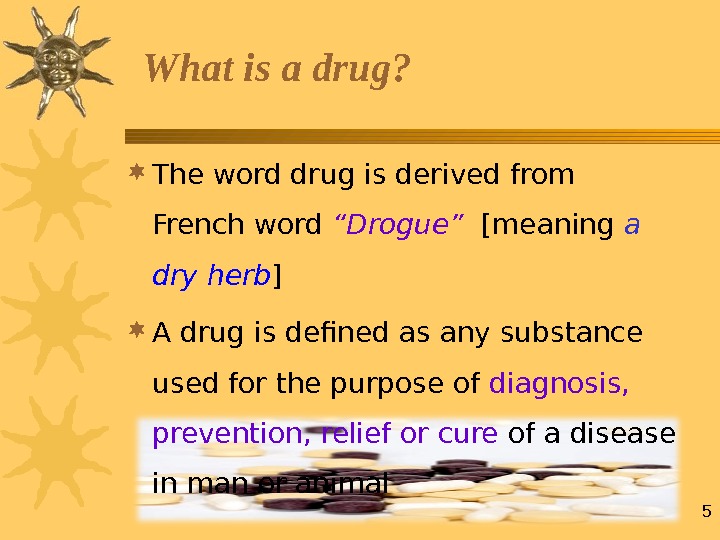


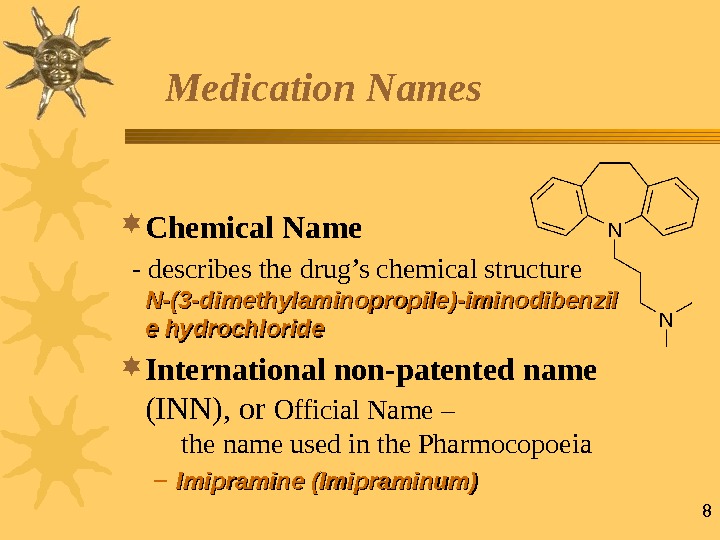

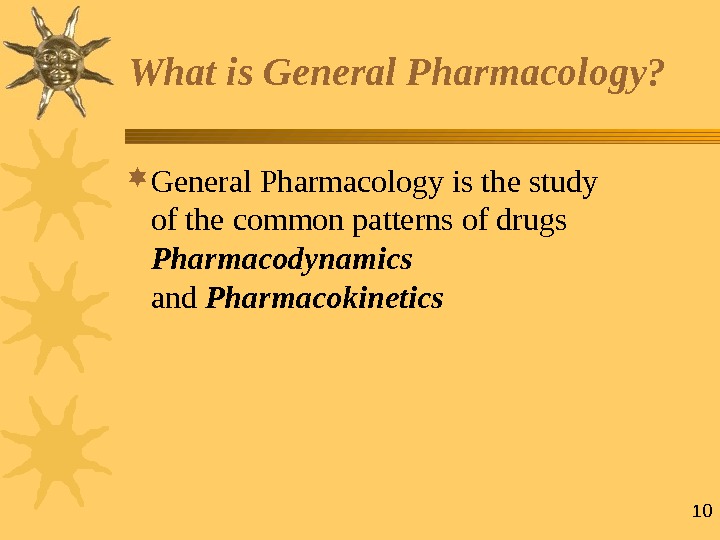

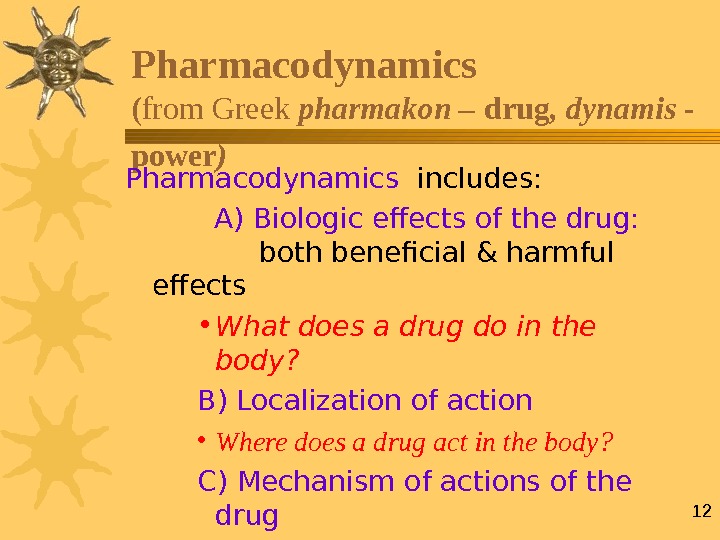
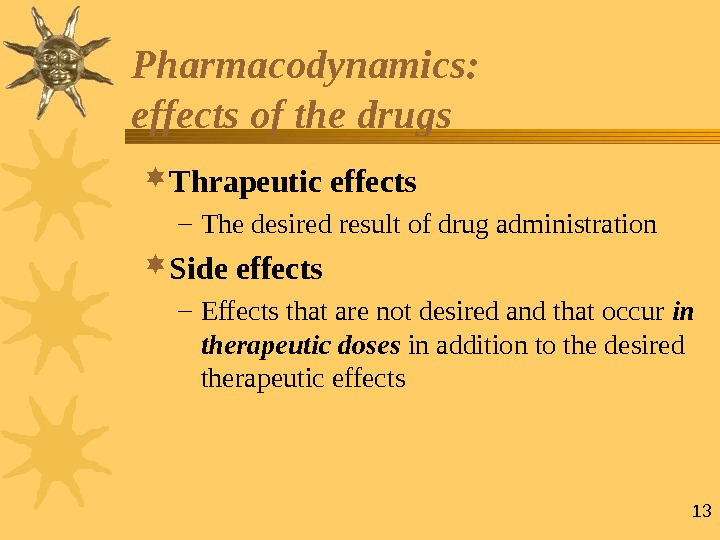


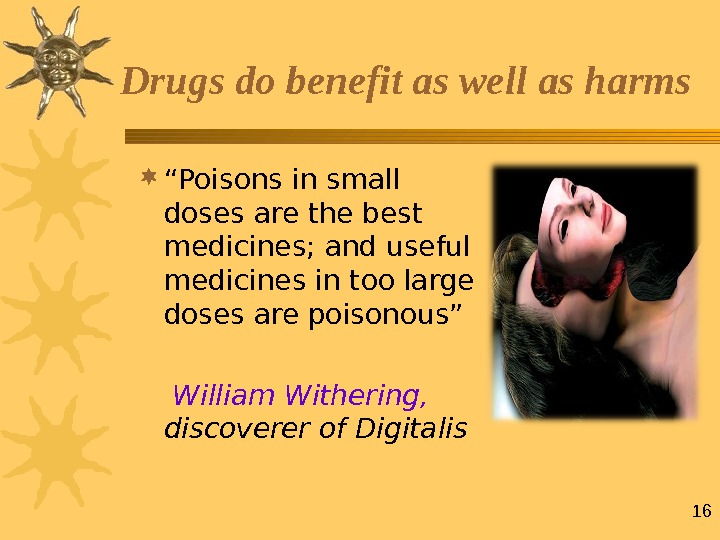



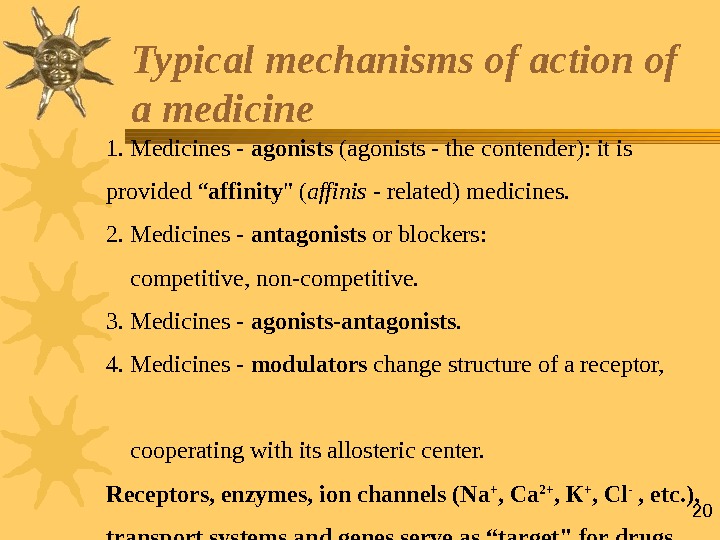






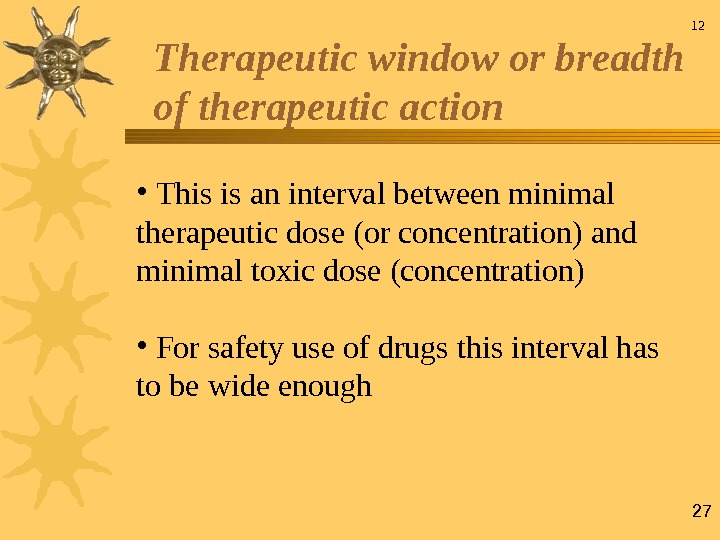


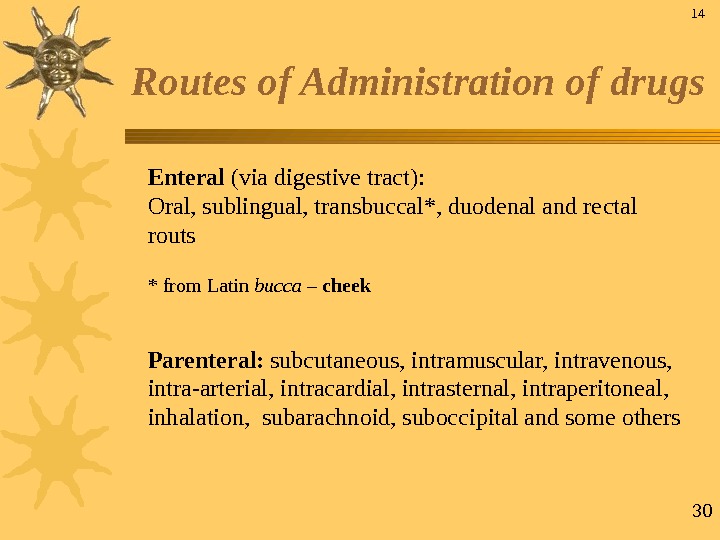




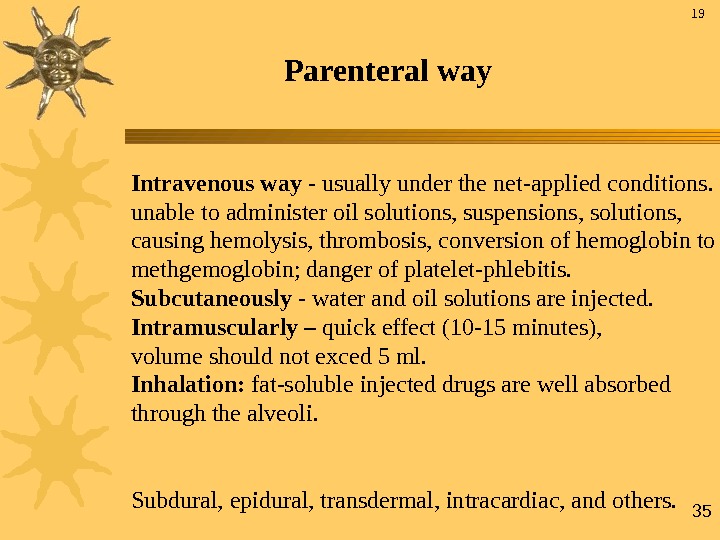
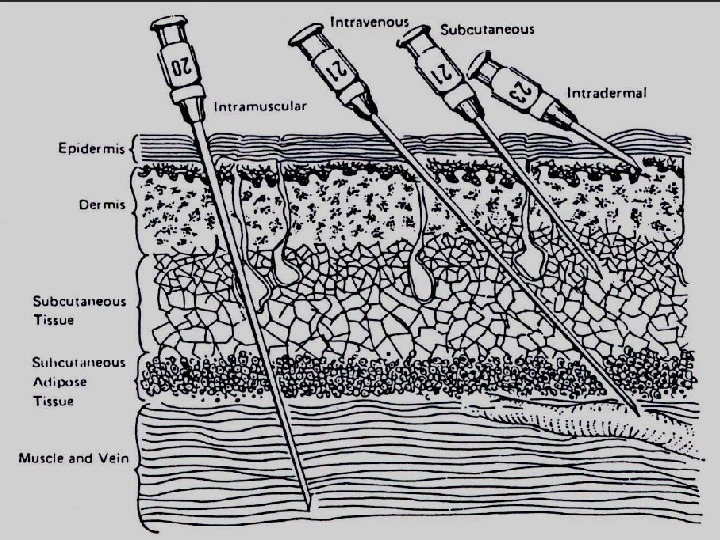
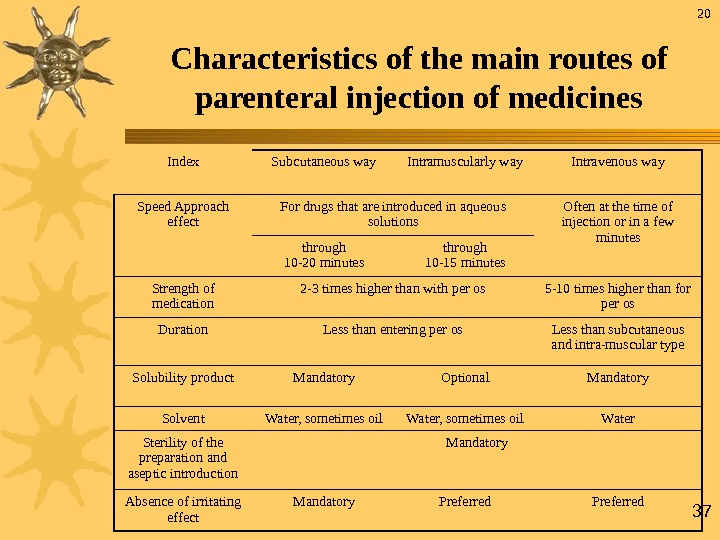




general_pharmacology_i_part.ppt
- Размер: 5.2 Mегабайта
- Количество слайдов: 41
Описание презентации 1 THE NATIONAL UNIVERSITY OF PHARMACY Pharmacology department по слайдам
 1 THE NATIONAL UNIVERSITY OF PHARMACY Pharmacology department Lecture topic: GENERAL PHARMACOLOGY (pharmacological alphabet) Sergey Yu. Shtrygol’ Doctor of Medicine, Professor A head of the Department of Pharmacology
1 THE NATIONAL UNIVERSITY OF PHARMACY Pharmacology department Lecture topic: GENERAL PHARMACOLOGY (pharmacological alphabet) Sergey Yu. Shtrygol’ Doctor of Medicine, Professor A head of the Department of Pharmacology
 2 Objectives What is pharmacology? What is a drug? Medication Names Pharmacological characteristic of drugs Pharmacodynamics Typical mechanisms of action of a medicine Doses Routes of Drugs Administration Steps to Administering Medication
2 Objectives What is pharmacology? What is a drug? Medication Names Pharmacological characteristic of drugs Pharmacodynamics Typical mechanisms of action of a medicine Doses Routes of Drugs Administration Steps to Administering Medication
 3 What is Pharmacology ? Pharmacology is a branch of medical science “ Pharmakon ” — Greek word means “an active principle” “ Logos ” — Greek word means “knowledge” So, Pharmacology is “ knowledge about drugs ” in common meaning
3 What is Pharmacology ? Pharmacology is a branch of medical science “ Pharmakon ” — Greek word means “an active principle” “ Logos ” — Greek word means “knowledge” So, Pharmacology is “ knowledge about drugs ” in common meaning
 4 In broad aspect, it is the subject that embraces the knowledge of history, source, physical and chemical properties, compounding, biochemical and physiological effects, mechanism of action, absorption, distribution in the body, storage, biotransformation (or metabolism), excretion and therapeutic and other uses of drugs. Definition
4 In broad aspect, it is the subject that embraces the knowledge of history, source, physical and chemical properties, compounding, biochemical and physiological effects, mechanism of action, absorption, distribution in the body, storage, biotransformation (or metabolism), excretion and therapeutic and other uses of drugs. Definition
 5 What is a drug? The word drug is derived from French word “Drogue” [meaning a dry herb ] A drug is defined as any substance used for the purpose of diagnosis, prevention, relief or cure of a disease in man or animal
5 What is a drug? The word drug is derived from French word “Drogue” [meaning a dry herb ] A drug is defined as any substance used for the purpose of diagnosis, prevention, relief or cure of a disease in man or animal
 6 Any substance or product that is used or intended to be used to modify or explore physiological system or pathological states for the benefit of the recipient. WHO Definition of drug
6 Any substance or product that is used or intended to be used to modify or explore physiological system or pathological states for the benefit of the recipient. WHO Definition of drug
 7 Sources of Drugs Animals Plants Minerals Synthetic Microbes Biotechnology
7 Sources of Drugs Animals Plants Minerals Synthetic Microbes Biotechnology
 8 Medication Names Chemical Name — describes the drug’s chemical structure N-N- (3 -(3 — dimethylaminopropile )-)- iminodibenzil e hydrochloride International non-patented name (INN), or Official Name – the name used in the Pharmocopoeia – Imipramine (Imipraminum)
8 Medication Names Chemical Name — describes the drug’s chemical structure N-N- (3 -(3 — dimethylaminopropile )-)- iminodibenzil e hydrochloride International non-patented name (INN), or Official Name – the name used in the Pharmocopoeia – Imipramine (Imipraminum)
 9 Medication Names Trade Name – the name the manufacturer uses to market the drug ММ elipramine (( Egis, Hungary )) Imizine ( ( Russia ))
9 Medication Names Trade Name – the name the manufacturer uses to market the drug ММ elipramine (( Egis, Hungary )) Imizine ( ( Russia ))
 10 What is General Pharmacology? General Pharmacology is the study of the common patterns of drugs Pharmacodynamics and Pharmacokinetics
10 What is General Pharmacology? General Pharmacology is the study of the common patterns of drugs Pharmacodynamics and Pharmacokinetics
 1111 Pharmacological characteristic of drugs Each drug has Pharmacokinetics Pharmacodynamics What body does to drug What drug does to bodydrug body
1111 Pharmacological characteristic of drugs Each drug has Pharmacokinetics Pharmacodynamics What body does to drug What drug does to bodydrug body
 12 Pharmacodynamics ( from Greek pharmakon – drug , dynamis — power ) Pharmacodynamics includes: A) Biologic effects of the drug: both beneficial & harmful effects • What does a drug do in the body? B) Localization of action • Where does a drug act in the body? C) Mechanism of actions of the drug • How does a drug act in the body?
12 Pharmacodynamics ( from Greek pharmakon – drug , dynamis — power ) Pharmacodynamics includes: A) Biologic effects of the drug: both beneficial & harmful effects • What does a drug do in the body? B) Localization of action • Where does a drug act in the body? C) Mechanism of actions of the drug • How does a drug act in the body?
 13 Pharmacodynamics: effects of the drugs Thrapeutic effects – The desired result of drug administration Side effects – Effects that are not desired and that occur in therapeutic doses in addition to the desired therapeutic effects
13 Pharmacodynamics: effects of the drugs Thrapeutic effects – The desired result of drug administration Side effects – Effects that are not desired and that occur in therapeutic doses in addition to the desired therapeutic effects
 14 Effects and side effects • Drug effects and side effects result from interaction with individual receptors • All drugs interact with more than one receptor • Endogenous molecules usually bind to multiple receptors in the same family • Drugs are designed to target specific receptor subtypes to reduce side effects • Increasing the concentration of the drug increases side effects • Patients experience different effects and side-effects
14 Effects and side effects • Drug effects and side effects result from interaction with individual receptors • All drugs interact with more than one receptor • Endogenous molecules usually bind to multiple receptors in the same family • Drugs are designed to target specific receptor subtypes to reduce side effects • Increasing the concentration of the drug increases side effects • Patients experience different effects and side-effects
 15 Drugs can do good as well as harms Beneficial effects/Therapeutic effects Harmful effects / Adverse effects So, the knowledge of basic pharmacology is essential for all prescribing physicians and especially for pharmacists. Drugs do benefit as well as harm
15 Drugs can do good as well as harms Beneficial effects/Therapeutic effects Harmful effects / Adverse effects So, the knowledge of basic pharmacology is essential for all prescribing physicians and especially for pharmacists. Drugs do benefit as well as harm
 16 “ Poisons in small doses are the best medicines; and useful medicines in too large doses are poisonous” William Withering, discoverer of Digitalis Drugs do benefit as well as harms
16 “ Poisons in small doses are the best medicines; and useful medicines in too large doses are poisonous” William Withering, discoverer of Digitalis Drugs do benefit as well as harms
 17 FACTORS THAT AFFECT Pharmacodynamics of MEDICINES Exogenous factors unrelated to the patient: chemical structure and physical properties of drugs, medicinal form, route of administration and dose, diet, food composition, environment, chrono-dependence Endogenous factors related to the patient: body weight, sex, age, physiological (pregnancy, hypodynamy, body temperature) and pathological (disease) conditions
17 FACTORS THAT AFFECT Pharmacodynamics of MEDICINES Exogenous factors unrelated to the patient: chemical structure and physical properties of drugs, medicinal form, route of administration and dose, diet, food composition, environment, chrono-dependence Endogenous factors related to the patient: body weight, sex, age, physiological (pregnancy, hypodynamy, body temperature) and pathological (disease) conditions
 18 Typical mechanisms of action of a medicine Basic «target» of action of a medicine is receptor Receptors are active groups of substrates’ macromolecules, with them a drug interacts. Receptors are the components of a cell membrane or cytosole that interact with a drug and initiate the chain of biochemical events leading to the drug’s observed effects
18 Typical mechanisms of action of a medicine Basic «target» of action of a medicine is receptor Receptors are active groups of substrates’ macromolecules, with them a drug interacts. Receptors are the components of a cell membrane or cytosole that interact with a drug and initiate the chain of biochemical events leading to the drug’s observed effects
 19 Types of receptors RR ions RR RRRR GG GG EE EE RR nucleus. Cell membrane m. RNA synthesisagonist R — receptor E — enzymes. G – G-proteins 1. Receptors directly controlling ion channel function. These are receptors coupled directly with ion channels (nicotinic cholinoreceptors, GABA A -receptors and glutamate receptors). 2. Receptors coupled with effector via ”G-protein – second messengers” or ”G-protein – ion channel” systems (muscarinic cholinoceptors, adrenoceptors). 3. Receptors directly controlling effector enzyme function. They are directly associated with thyrosine kinase and regulate phosphorilation of proteins (insulin receptors and a number of growth factors function this way). 4. Receptors controlling DNA transcription are intracellular receptors (soluble cytosolic or nuclear proteins) unlike membrane receptors of types 1 -3. Steroid and thyroid hormones interact with this type of receptors.
19 Types of receptors RR ions RR RRRR GG GG EE EE RR nucleus. Cell membrane m. RNA synthesisagonist R — receptor E — enzymes. G – G-proteins 1. Receptors directly controlling ion channel function. These are receptors coupled directly with ion channels (nicotinic cholinoreceptors, GABA A -receptors and glutamate receptors). 2. Receptors coupled with effector via ”G-protein – second messengers” or ”G-protein – ion channel” systems (muscarinic cholinoceptors, adrenoceptors). 3. Receptors directly controlling effector enzyme function. They are directly associated with thyrosine kinase and regulate phosphorilation of proteins (insulin receptors and a number of growth factors function this way). 4. Receptors controlling DNA transcription are intracellular receptors (soluble cytosolic or nuclear proteins) unlike membrane receptors of types 1 -3. Steroid and thyroid hormones interact with this type of receptors.
 201. Medicines — agonists (agonists — the contender): it is provided “ affinity » ( affinis — related) medicines. 2. Medicines — antagonists or blockers: competitive, non-competitive. 3. Medicines — agonists — antagonists. 4. Medicines — modulators change structure of a receptor, cooperating with its allosteric center. Receptors, enzymes, ion channels (Na + , Са 2+ , К + , С l — , etc. ), transport systems and genes serve as “target» for drugs Typical mechanisms of action of a medicine
201. Medicines — agonists (agonists — the contender): it is provided “ affinity » ( affinis — related) medicines. 2. Medicines — antagonists or blockers: competitive, non-competitive. 3. Medicines — agonists — antagonists. 4. Medicines — modulators change structure of a receptor, cooperating with its allosteric center. Receptors, enzymes, ion channels (Na + , Са 2+ , К + , С l — , etc. ), transport systems and genes serve as “target» for drugs Typical mechanisms of action of a medicine
 21 Kinds of action of a medicine For the analysis pharmacodynamic distinguish: — Local and resorptive ( or systemic) action; — Direct and reflex action; — Selective (predominant) and non-selective action; — Principal and adverse effects; — Reversible (characteristic of most drugs) and irreversible action (in a case of covalent bond, as a rule).
21 Kinds of action of a medicine For the analysis pharmacodynamic distinguish: — Local and resorptive ( or systemic) action; — Direct and reflex action; — Selective (predominant) and non-selective action; — Principal and adverse effects; — Reversible (characteristic of most drugs) and irreversible action (in a case of covalent bond, as a rule).
 22 Pharmacotherapeutical kinds of action Etiotropic Pathogenetic Symptomatic Stimulative Subsitutive Palliative (time alleviation)
22 Pharmacotherapeutical kinds of action Etiotropic Pathogenetic Symptomatic Stimulative Subsitutive Palliative (time alleviation)
 23 Negative kinds of drug action Cumulation: material, functional. Accustoming (tolerance), tachyphylaxis (rapidly diminishing response to successive doses of a drug, rendering it less effective. The effect is common with drugs acting on the nervous system). Predilection; euphoria; abstinence. Medicinal allergy. Medicinal idiosyncrasy. Dysbiosis (dysbacteriosis). Embriotoxity teratogenic mutagen. Blastomogenic (cancerogenic). Withdrawal Syndrome
23 Negative kinds of drug action Cumulation: material, functional. Accustoming (tolerance), tachyphylaxis (rapidly diminishing response to successive doses of a drug, rendering it less effective. The effect is common with drugs acting on the nervous system). Predilection; euphoria; abstinence. Medicinal allergy. Medicinal idiosyncrasy. Dysbiosis (dysbacteriosis). Embriotoxity teratogenic mutagen. Blastomogenic (cancerogenic). Withdrawal Syndrome
 24 Kinds of doses Therapeutical: — Minimal -Single -Isolethal -Average -Daily -Isoeffective -Maximal -Course -Equimolecular Shock and supporting doses 8 Dose is a quantity of a substance for intake. Dose is usually measured in grams or gram fractions (mg and so on ) , in special cases – in radioactivity units or in biological units (in biostandardization). For more accurate dosing of drugs their amount is calculated per 1 kg of body mass (for example, mg/kg) or by body surface area (per 1 m 2).
24 Kinds of doses Therapeutical: — Minimal -Single -Isolethal -Average -Daily -Isoeffective -Maximal -Course -Equimolecular Shock and supporting doses 8 Dose is a quantity of a substance for intake. Dose is usually measured in grams or gram fractions (mg and so on ) , in special cases – in radioactivity units or in biological units (in biostandardization). For more accurate dosing of drugs their amount is calculated per 1 kg of body mass (for example, mg/kg) or by body surface area (per 1 m 2).
 25 Therapeutic index Where LD 50 — the dose that causes death in 50% of experimental animals; ED 50 — the dose that causes pharmacological effect in 50% of animals. 9 TI = LD 50 ______________
25 Therapeutic index Where LD 50 — the dose that causes death in 50% of experimental animals; ED 50 — the dose that causes pharmacological effect in 50% of animals. 9 TI = LD 50 ______________
 26 “ Dose-effect” dependence Inactive doses Therapeutic window Toxic doses Threshold (Minimally active dose) Minimal toxic dose Lethal dose Dose. E ff e c t
26 “ Dose-effect” dependence Inactive doses Therapeutic window Toxic doses Threshold (Minimally active dose) Minimal toxic dose Lethal dose Dose. E ff e c t
 27 • This is an interval between minimal therapeutic dose (or concentration) and minimal toxic dose (concentration) • For safety use of drugs this interval has to be wide enough 12 Therapeutic window or breadth of therapeutic action
27 • This is an interval between minimal therapeutic dose (or concentration) and minimal toxic dose (concentration) • For safety use of drugs this interval has to be wide enough 12 Therapeutic window or breadth of therapeutic action

 29 In geriatrics — 1/2 -2/3 from an average therapeutic dose The children’s dose (А) is calculated using the formulas: B — a dose of an adult person; а — age of a child; В — weight of a child. The important quality of a medicine is not the “strenth» of its action but the efficiency of a safe dose 11 A = a __________ B ∙ ( a + 12) A = B __________ (70 kg) ∙ B where
29 In geriatrics — 1/2 -2/3 from an average therapeutic dose The children’s dose (А) is calculated using the formulas: B — a dose of an adult person; а — age of a child; В — weight of a child. The important quality of a medicine is not the “strenth» of its action but the efficiency of a safe dose 11 A = a __________ B ∙ ( a + 12) A = B __________ (70 kg) ∙ B where
 30 Routes of Administration of drugs Enteral (via digestive tract): Oral, sublingual, transbuccal*, duodenal and r ес tal routs * from Latin bucca – cheek Parenteral: subcutaneous, intramuscular, intravenous, intra-arterial, intracardial, intrasternal, intraperitoneal, inhalation, subarachnoid, suboccipital and some others
30 Routes of Administration of drugs Enteral (via digestive tract): Oral, sublingual, transbuccal*, duodenal and r ес tal routs * from Latin bucca – cheek Parenteral: subcutaneous, intramuscular, intravenous, intra-arterial, intracardial, intrasternal, intraperitoneal, inhalation, subarachnoid, suboccipital and some others
 31 Oral (by mouth, internally, pp еr os ): ): The most common administration rote Positive: is a convenient and simple way, gastrointestinal tract is the «biological filter», medical personnel and equipment are not needed, many drugs are used 30 -40 minutes before eating or 3 -4 hours after it Disadvantages: the concentration of drugs is not exact, drugs can be destroyed in the gastrointestinal tract by interaction with food enzymes and hydrochloric acid, is not suitable for the first aid, speed and completeness of absorption of drugs can vary, inactivation in the liver and action on it are possible
31 Oral (by mouth, internally, pp еr os ): ): The most common administration rote Positive: is a convenient and simple way, gastrointestinal tract is the «biological filter», medical personnel and equipment are not needed, many drugs are used 30 -40 minutes before eating or 3 -4 hours after it Disadvantages: the concentration of drugs is not exact, drugs can be destroyed in the gastrointestinal tract by interaction with food enzymes and hydrochloric acid, is not suitable for the first aid, speed and completeness of absorption of drugs can vary, inactivation in the liver and action on it are possible
 32 Oral route of administration of medicines Introduced inside the mouth Throgh the esophagus enters the stomach Absorbed from the stomach to the liver through a capillary From the liver medicine comes to the bottom nailed veins Then to the right atrium and right ventricle. From the right ventricle to the pulmonary artery to lungs. Then to the left atrium and left ventricle The left ventricle enters the aorta and then to organs and tissues
32 Oral route of administration of medicines Introduced inside the mouth Throgh the esophagus enters the stomach Absorbed from the stomach to the liver through a capillary From the liver medicine comes to the bottom nailed veins Then to the right atrium and right ventricle. From the right ventricle to the pulmonary artery to lungs. Then to the left atrium and left ventricle The left ventricle enters the aorta and then to organs and tissues
 33 Rectal administration Positively: can be used in the unconscious, patients with vomiting, stomach diseases, in mentally ill, children. Absorbtion speed is close to intramuscular way (5 -15 minutes). There is a «biological filtration” and no effect of the first passage through the liver. Disadvantages: uncomfortable way, not all drugs are absorbed. Sublingual Quick adsorbtion, drugs are not destroyed in the gastrointestinal tract and less — in the liver. Only for potent drugs.
33 Rectal administration Positively: can be used in the unconscious, patients with vomiting, stomach diseases, in mentally ill, children. Absorbtion speed is close to intramuscular way (5 -15 minutes). There is a «biological filtration” and no effect of the first passage through the liver. Disadvantages: uncomfortable way, not all drugs are absorbed. Sublingual Quick adsorbtion, drugs are not destroyed in the gastrointestinal tract and less — in the liver. Only for potent drugs.
 34 Parenteral way Positive: fast action and accurate dosing, introduction to the unconscious is possible, drugs are not destroyed in the gastrointestinal tract including the liver. Disadvantages: the need of the strict asepsis, the participation of medical personnel and equipment is needed, the risk of infection, introduction is accompanied with pain.
34 Parenteral way Positive: fast action and accurate dosing, introduction to the unconscious is possible, drugs are not destroyed in the gastrointestinal tract including the liver. Disadvantages: the need of the strict asepsis, the participation of medical personnel and equipment is needed, the risk of infection, introduction is accompanied with pain.
 35 Intravenous way — usually under the net-applied conditions. unable to administer oil solutions, suspensions, solutions, causing hemolysis, thrombosis, conversion of hemoglobin to methgemoglobin; danger of platelet-phlebitis. Subcutaneously — water and oil solutions are injected. Intramuscularly – quick effect (10 -15 minutes), volume should not exced 5 ml. Inhalation: fat-soluble injected drugs are well absorbed through the alveoli. Subdural, epidural, transdermal, intracardiac, and others. 19 Parenteral way
35 Intravenous way — usually under the net-applied conditions. unable to administer oil solutions, suspensions, solutions, causing hemolysis, thrombosis, conversion of hemoglobin to methgemoglobin; danger of platelet-phlebitis. Subcutaneously — water and oil solutions are injected. Intramuscularly – quick effect (10 -15 minutes), volume should not exced 5 ml. Inhalation: fat-soluble injected drugs are well absorbed through the alveoli. Subdural, epidural, transdermal, intracardiac, and others. 19 Parenteral way

 37 Index Subcutaneous way Intramuscularly way Intravenous way Speed Approach effect For drugs that are introduced in aqueous solutions Often at the time of injection or in a few minutes through 10 -20 minutes through 10 -15 minutes Strength of medication 2 -3 times higher than with per os 5 -10 times higher than for per os Duration Less than entering per os Less than subcutaneous and intra-muscular type Solubility product Mandatory Optional Mandatory Solvent Water, sometimes oil Water Sterility of the preparation and aseptic introduction Mandatory Absence of irritating effect Mandatory Preferred. Characteristics of the main routes of parenteral injection of medicines
37 Index Subcutaneous way Intramuscularly way Intravenous way Speed Approach effect For drugs that are introduced in aqueous solutions Often at the time of injection or in a few minutes through 10 -20 minutes through 10 -15 minutes Strength of medication 2 -3 times higher than with per os 5 -10 times higher than for per os Duration Less than entering per os Less than subcutaneous and intra-muscular type Solubility product Mandatory Optional Mandatory Solvent Water, sometimes oil Water Sterility of the preparation and aseptic introduction Mandatory Absence of irritating effect Mandatory Preferred. Characteristics of the main routes of parenteral injection of medicines
 38 Physicians and pharmacists should remember that the right choice of dose, route of introduction of drugs, application of preparations’ etiotropic, pathogenetic, symptomatic action — the important condition of pharmacotherapy of any disease. 21 Steps to Medication Administration
38 Physicians and pharmacists should remember that the right choice of dose, route of introduction of drugs, application of preparations’ etiotropic, pathogenetic, symptomatic action — the important condition of pharmacotherapy of any disease. 21 Steps to Medication Administration
 39 • Select Proper Medication – Avoid contamination – Check Expiration Date – Check For Signs of Contamination • Discoloration • Cloudiness • Particulate Matter. Steps to Medication Administration
39 • Select Proper Medication – Avoid contamination – Check Expiration Date – Check For Signs of Contamination • Discoloration • Cloudiness • Particulate Matter. Steps to Medication Administration
 40 Verify Form & Route Inform Patient of Order – Inquire about allergies Recheck Medication – Expiration date – Contamination – At least two more times after initial check. Steps to Medication Administration
40 Verify Form & Route Inform Patient of Order – Inquire about allergies Recheck Medication – Expiration date – Contamination – At least two more times after initial check. Steps to Medication Administration
 41 Thank you!
41 Thank you!

